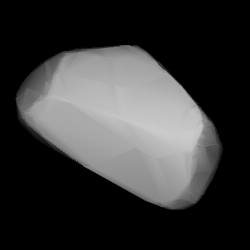497 Iva
 Modelled shape of Iva from its lightcurve | |
| Discovery | |
|---|---|
| Discovered by | Raymond Smith Dugan |
| Discovery site | Heidelberg |
| Discovery date | 4 November 1902 |
| Designations | |
| (497) Iva | |
| Pronunciation | /ˈaɪvə/[1] |
| 1902 KJ | |
| Orbital characteristics[2] | |
| Epoch 31 July 2016 (JD 2457600.5) | |
| Uncertainty parameter 0 | |
| Observation arc | 113.45 yr (41,438 d) 113.45 yr (41438 d) |
| Aphelion | 3.7065 AU (554.48 Gm) |
| Perihelion | 1.9966 AU (298.69 Gm) |
| 2.8516 AU (426.59 Gm) | |
| Eccentricity | 0.29981 |
| 4.82 yr (1,758.8 d) 4.82 yr (1758.8 d) | |
| 242.202° | |
| 0° 12m 16.848s / day | |
| Inclination | 4.8205° |
| 6.3305° | |
| 3.5819° | |
| Physical characteristics | |
| 4.620 h (0.1925 d) | |
| 10.02 | |
Iva (minor planet designation: 497 Iva) is a main-belt asteroid orbiting the Sun, not to be confused with 1627 Ivar. It was discovered by American astronomer R. S. Dugan on 4 November 1902, and was named for Iva Shores, the young daughter of the family where he was staying in Heidelberg.[3] This object is orbiting at a distance of 2.85 AU with a period of 4.82 yr and an eccentricity of 0.3. The orbital plane is inclined at an angle of 4.8° to the plane of the ecliptic.[2]
This asteroid is classified as an M-type asteroid and is considered anhydrous[4] but oxidized.[5] Further analysis of the spectra suggests the "presence of either an olivine or high-Ca pyroxene phase in addition to orthopyroxene ± Type B clinopyroxene".[6] Analysis of light curves based on photometric data show a rotation period of 4.621±0.001 h with a brightness variation of 0.34±0.02 in magnitude.[7]
References[edit]
- ^ Noah Webster (1884) A Practical Dictionary of the English Language
- ^ a b "497 Iva (1902 KJ)". JPL Small-Body Database. NASA/Jet Propulsion Laboratory. Retrieved 6 May 2016.
- ^ Schmadel, Lutz D. (2013), Dictionary of Minor Planet Names, Springer Berlin Heidelberg, p. 83, ISBN 9783662066157
- ^ Birlan, M.; et al. (November 2007), "Spectral properties of nine M-type asteroids" (PDF), Astronomy and Astrophysics, 475 (2): 747–754, Bibcode:2007A&A...475..747B, doi:10.1051/0004-6361:20077914.
- ^ Busarev, V. V.; Taran, M. N. (November 2002), Warmbein, Barbara (ed.), "On the spectral similarity of carbonaceous chondrites and some hydrated and oxidized asteroids", Proceedings of Asteroids, Comets, Meteors - ACM 2002. International Conference, 29 July - 2 August 2002, Berlin, Germany, Noordwijk, Netherlands: ESA Publications Division, pp. 933–936, Bibcode:2002ESASP.500..933B, ISBN 92-9092-810-7.
- ^ Hardersen, Paul S.; et al. (December 2011), "The M-/X-asteroid menagerie: Results of an NIR spectral survey of 45 main-belt asteroids", Meteoritics & Planetary Science, 46 (12): 1910–1938, Bibcode:2011M&PS...46.1910H, doi:10.1111/j.1945-5100.2011.01304.x
- ^ Warner, Brian D. (July 2009), "Asteroid Lightcurve Analysis at the Palmer Divide Observatory: 2008 December - 2009 March", Bulletin of the Minor Planets Section of the Association of Lunar and Planetary Observers, 36 (3): 109–116, Bibcode:2009MPBu...36..109W.
External links[edit]
- Lightcurve plot of 497 Iva, Palmer Divide Observatory, B. D. Warner (2009)
- Asteroid Lightcurve Database (LCDB), query form (info Archived 16 December 2017 at the Wayback Machine)
- Dictionary of Minor Planet Names, Google books
- Asteroids and comets rotation curves, CdR – Observatoire de Genève, Raoul Behrend
- Discovery Circumstances: Numbered Minor Planets (1)-(5000) – Minor Planet Center
- 497 Iva at AstDyS-2, Asteroids—Dynamic Site
- 497 Iva at the JPL Small-Body Database
